 One of the more common mishaps to plague coinage presses since their very inception is “clashed dies” (known in mint parlance as “come together”). Clashed dies (or die clash) occurs when the hammer and anvil die smack into each other when a planchet fails to get fed into the striking chamber. Ordinarily, the dies are adjusted so that at their closest approach there is still little a bit of clearance between them even in the absence of a planchet. However, if they fall out of adjustment, contact can occur.
One of the more common mishaps to plague coinage presses since their very inception is “clashed dies” (known in mint parlance as “come together”). Clashed dies (or die clash) occurs when the hammer and anvil die smack into each other when a planchet fails to get fed into the striking chamber. Ordinarily, the dies are adjusted so that at their closest approach there is still little a bit of clearance between them even in the absence of a planchet. However, if they fall out of adjustment, contact can occur.
 When dies clash, each die leaves a light and incomplete impression of its design on the opposing die. The impressions, which are raised and normally-oriented on the die, are transferred to each newly struck coin as a set of incuse (sunken), mirror-image design elements. These incuse design elements are known as “clash marks”. The most superficial areas of the die face are the ones most vulnerable to die clash. These include the field and the shallowest recesses in the die face, which equate to the areas of lowest relief on the coin.
When dies clash, each die leaves a light and incomplete impression of its design on the opposing die. The impressions, which are raised and normally-oriented on the die, are transferred to each newly struck coin as a set of incuse (sunken), mirror-image design elements. These incuse design elements are known as “clash marks”. The most superficial areas of the die face are the ones most vulnerable to die clash. These include the field and the shallowest recesses in the die face, which equate to the areas of lowest relief on the coin.
 Weak clash marks generally don’t excite me, as they are common in all years and all denominations. I do make an exception, though, for clash marks that are wildly out of place as the result of a die misalignment. A die misalignment (specifically a horizontal misalignment) occurs when one die is offset relative to the other die. Since the anvil die is confined by a fixed collar, it’s usually the hammer die that shifts to one side. There are some notable exceptions, though (Diamond, 2004c)
Weak clash marks generally don’t excite me, as they are common in all years and all denominations. I do make an exception, though, for clash marks that are wildly out of place as the result of a die misalignment. A die misalignment (specifically a horizontal misalignment) occurs when one die is offset relative to the other die. Since the anvil die is confined by a fixed collar, it’s usually the hammer die that shifts to one side. There are some notable exceptions, though (Diamond, 2004c)
 Over the last few years quite a few radically misaligned die clashes (often referred to as “MAD clashes”) have been found among Lincoln cents. Almost all are from the 1990’s, with one as recent as the year 2000. Many of these clashes also show evidence of a major vertical misalignment (tilted die error). In other words, the opposing die faces were not perfectly parallel to each other when contact occurred. One of the dies (presumably the hammer die) struck the opposite die at an angle, leaving (or picking up) an impression of the design at just one pole. A few of the clashes also show evidence that one of the dies was rotated or pivoted – hence the additional terms “rotated die clash” and “pivoted die clash”.
Over the last few years quite a few radically misaligned die clashes (often referred to as “MAD clashes”) have been found among Lincoln cents. Almost all are from the 1990’s, with one as recent as the year 2000. Many of these clashes also show evidence of a major vertical misalignment (tilted die error). In other words, the opposing die faces were not perfectly parallel to each other when contact occurred. One of the dies (presumably the hammer die) struck the opposite die at an angle, leaving (or picking up) an impression of the design at just one pole. A few of the clashes also show evidence that one of the dies was rotated or pivoted – hence the additional terms “rotated die clash” and “pivoted die clash”.
 I wrote two earlier articles on this phenomenon for the magazine Errorscope (Diamond, 2004a,b). This is the magazine put out by CONECA – The Combined Organizations of Numismatic Error Collectors of America. Since a number of new specimens have been discovered since my last treatment, it seemed opportune to present an update.
I wrote two earlier articles on this phenomenon for the magazine Errorscope (Diamond, 2004a,b). This is the magazine put out by CONECA – The Combined Organizations of Numismatic Error Collectors of America. Since a number of new specimens have been discovered since my last treatment, it seemed opportune to present an update.
 Let’s go through a line-up of the best of these misaligned die clashes, in chronological order. Since some of the readers of Mint Error News don’t subscribe to Errorscope, this account will cover all of the best specimens, old and new.
Let’s go through a line-up of the best of these misaligned die clashes, in chronological order. Since some of the readers of Mint Error News don’t subscribe to Errorscope, this account will cover all of the best specimens, old and new.
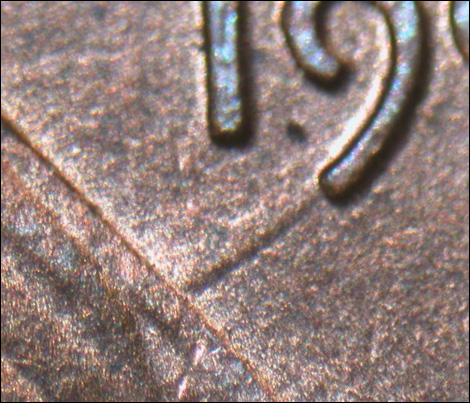
Figure 1. Misaligned and tilted die clash in a 1992 cent. A curved ridge representing the edge of the field portion of the obverse die is located to the left of Lincoln’s coat. One or two letter traces are located just inside the curve. Coin courtesy of Richard Imburgia.
 Figure 1 shows the earliest example to date – a 1992 cent discovered by Richard Imburgia. Richard has been relentless in his pursuit of MAD clash cents, and has discovered a considerable number of new examples over the last three years. In this particular specimen we see a ridge representing the edge of the field portion of the die. Just above that are faint letter impressions. In reconstructing the events leading to this and all the other clashes under discussion, I am assuming that the reverse die was fixed and normally oriented in all three planes. Whether this was actually the case will be discussed at the end of this article. In this coin, the obverse die was evidently misaligned about 20% toward the south and also strongly tilted, so that it made contact with the northern pole of the reverse die. The vast majority of MAD clash cents show a misalignment of the obverse die toward the south. It is impossible to make out the letters, so there’s no way to tell whether the obverse die was also rotated or pivoted.
Figure 1 shows the earliest example to date – a 1992 cent discovered by Richard Imburgia. Richard has been relentless in his pursuit of MAD clash cents, and has discovered a considerable number of new examples over the last three years. In this particular specimen we see a ridge representing the edge of the field portion of the die. Just above that are faint letter impressions. In reconstructing the events leading to this and all the other clashes under discussion, I am assuming that the reverse die was fixed and normally oriented in all three planes. Whether this was actually the case will be discussed at the end of this article. In this coin, the obverse die was evidently misaligned about 20% toward the south and also strongly tilted, so that it made contact with the northern pole of the reverse die. The vast majority of MAD clash cents show a misalignment of the obverse die toward the south. It is impossible to make out the letters, so there’s no way to tell whether the obverse die was also rotated or pivoted.
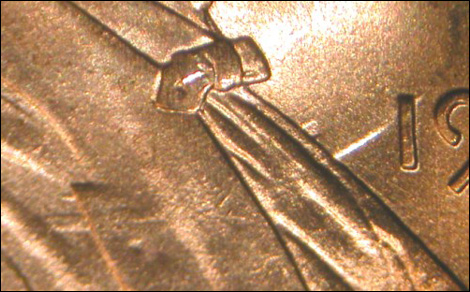
Figure 2. Misaligned and tilted die clash in a 1995 cent. Coin acquired from Mike Ellis.
 Figure 2 shows the best-known and most easily acquired example – a 1995 cent. Here we see a raised impression of the edge of the field portion of the die and, above that, letter traces. The letter traces are clear enough that I can make out the “F” of “oF” protruding from the front of Lincoln’s coat and the “ES” of STATES within the bust. On the reverse face, you can just see the outline of the front of Lincoln’s coat passing through the “F” of “oF”. The physical evidence once again indicates that the obverse die was tilted and misaligned toward the south, with the shift amounting to about 20% of the width of the obverse die face.
Figure 2 shows the best-known and most easily acquired example – a 1995 cent. Here we see a raised impression of the edge of the field portion of the die and, above that, letter traces. The letter traces are clear enough that I can make out the “F” of “oF” protruding from the front of Lincoln’s coat and the “ES” of STATES within the bust. On the reverse face, you can just see the outline of the front of Lincoln’s coat passing through the “F” of “oF”. The physical evidence once again indicates that the obverse die was tilted and misaligned toward the south, with the shift amounting to about 20% of the width of the obverse die face.
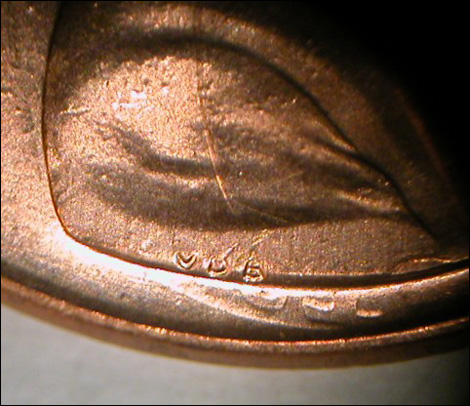
Figure 3. Tilted and pivoted die clash in a 1996 cent.
 The following year was quite busy, with no less than three cases showcased here. Figure 3 shows a 1996 Lincoln cent with the incuse letters “ST” from STATES peeking out from beneath Lincoln’s bust, between the edge of the bust and the design rim. Just below the letters is a ridge representing the edge of the field portion of the die. The obverse die shows no obvious horizontal misalignment, but it was tilted and pivoted. The obverse die had pivoted counterclockwise, with an axis of rotation probably located somewhere near the rim between 1:00 and 5:00.
The following year was quite busy, with no less than three cases showcased here. Figure 3 shows a 1996 Lincoln cent with the incuse letters “ST” from STATES peeking out from beneath Lincoln’s bust, between the edge of the bust and the design rim. Just below the letters is a ridge representing the edge of the field portion of the die. The obverse die shows no obvious horizontal misalignment, but it was tilted and pivoted. The obverse die had pivoted counterclockwise, with an axis of rotation probably located somewhere near the rim between 1:00 and 5:00.
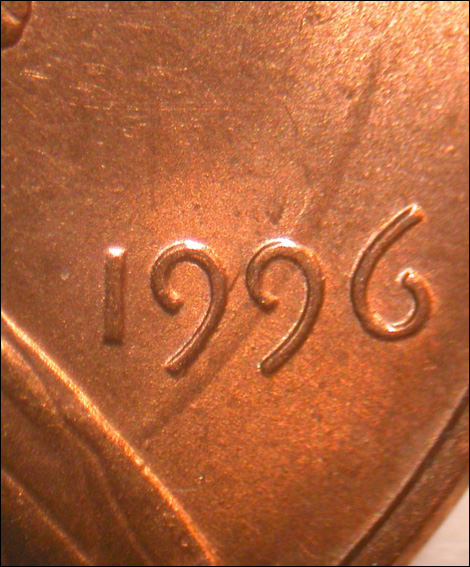
Figure 4. Misaligned and tilted die clash in a second 1996 cent. Coin courtesy of Richard Imburgia.
 The second 1996 specimen is shown in Figure 4 and comes from Richard Imburgia. We can see the familiar curved ridge with letter impressions just inside the curve. They seem to represent the “ER” of AMERICA. Here it looks like the obverse die shifted about 20% to the southeast, with the now familiar downward tilt.
The second 1996 specimen is shown in Figure 4 and comes from Richard Imburgia. We can see the familiar curved ridge with letter impressions just inside the curve. They seem to represent the “ER” of AMERICA. Here it looks like the obverse die shifted about 20% to the southeast, with the now familiar downward tilt.
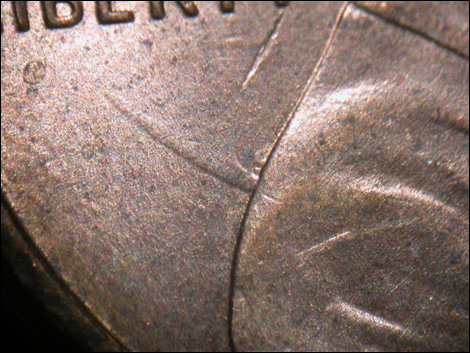
Figure 5. Misaligned and tilted die clash in a third 1996 cent. Coin courtesy of Richard Imburgia.
 The third 1996 specimen also comes from Richard Imburgia (Figure 5). It shows the usual curved ridge (again from the edge of the field portion of the die) and a faint letter trace. The letter might represent the “S” of STATES. It appears the obverse die shifted to south or southwest, but certainly tilted down toward the southwest position. If the letter identification is correct, then the die appears to have undergone a counterclockwise rotation as well.
The third 1996 specimen also comes from Richard Imburgia (Figure 5). It shows the usual curved ridge (again from the edge of the field portion of the die) and a faint letter trace. The letter might represent the “S” of STATES. It appears the obverse die shifted to south or southwest, but certainly tilted down toward the southwest position. If the letter identification is correct, then the die appears to have undergone a counterclockwise rotation as well.
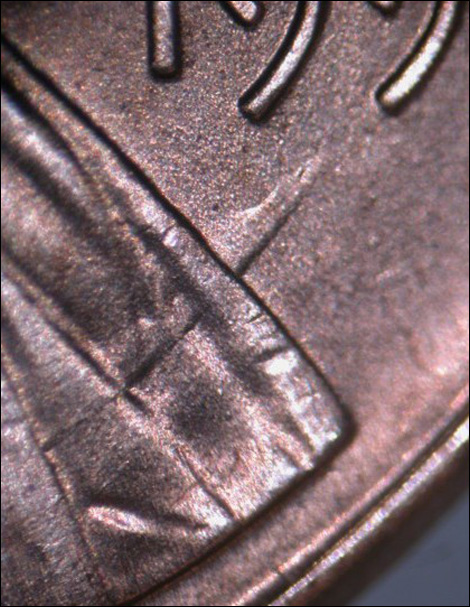
Figure 6. The first of three clashes in a single 1997 cent. This clash shows an extreme misalignment along with die tilt. Coin courtesy of Richard Imburgia
 The newest – and wildest – specimen is also an Imburgia discovery. This 1997 cent shows no less than three misaligned die clashes, each one in a different orientation relative to the others. The strongest clash emerges from the front of Lincoln’s coat where we see a curved ridge and letter traces just above it (Figure 6). I cannot identify the letters, unfortunately. Below the bust, on the inner border of the design rim, we see a second clash represented by the tops of several letters – also unidentified (Figure 7). Finally, there is a faint clash in the center of Lincoln’s coat (Figure 8). It appears that the strongest clash (Fig. 6) occurred as the die was shifted toward the south (or southeast) and tilted toward the southeast. The medium-strength clash (Fig. 7) apparently occurred when the die was simply tilted down; no horizontal misalignment is indicated.
The newest – and wildest – specimen is also an Imburgia discovery. This 1997 cent shows no less than three misaligned die clashes, each one in a different orientation relative to the others. The strongest clash emerges from the front of Lincoln’s coat where we see a curved ridge and letter traces just above it (Figure 6). I cannot identify the letters, unfortunately. Below the bust, on the inner border of the design rim, we see a second clash represented by the tops of several letters – also unidentified (Figure 7). Finally, there is a faint clash in the center of Lincoln’s coat (Figure 8). It appears that the strongest clash (Fig. 6) occurred as the die was shifted toward the south (or southeast) and tilted toward the southeast. The medium-strength clash (Fig. 7) apparently occurred when the die was simply tilted down; no horizontal misalignment is indicated.
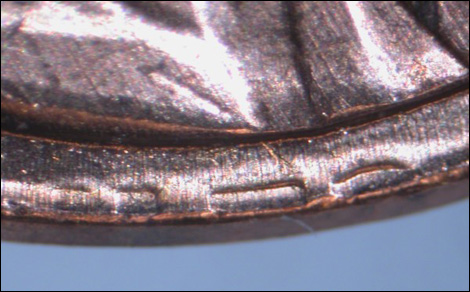
Figure 7. The second of three clashes in this 1997 cent. Letter impressions just inside the design rim indicate die tilt only.
 The weakest clash (Fig. 8) seems to represent another combination of horizontal misalignment and vertical misalignment.
The weakest clash (Fig. 8) seems to represent another combination of horizontal misalignment and vertical misalignment.
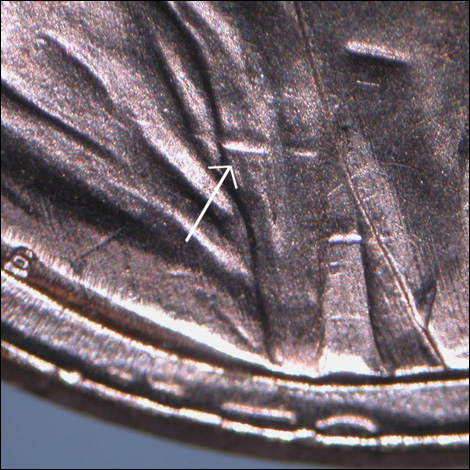
Figure 8. The faintest of the three die clashes in this 1997 takes the form of a faint curved ridge in the middle of Lincoln’s coat (arrow).
 Things are pretty quiet the next year, but heat up again in 1999.
Things are pretty quiet the next year, but heat up again in 1999.
Our first 1999 specimen comes from G.J. Lawson and shows a curved ridge emerging from the back of Lincoln’s coat with a single letter trace (“T”?) just inside the curve (Figure 9). Once again, the evidence indicates a strong horizontal misalignment toward the south and a downward tilt toward the south-southwest.
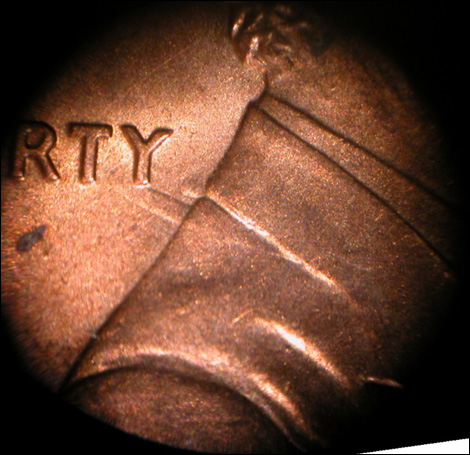
Figure 9. A 1999 cent with a misaligned and tilted die clash to the left of Lincoln’s coat. Coin courtesy of G.J. Lawson.
 The second specimen from 1999 – once again from Richard Imburgia -- is only represented by a curved ridge that occupies a similar position to the first 1999 specimen (Figure 10).
The second specimen from 1999 – once again from Richard Imburgia -- is only represented by a curved ridge that occupies a similar position to the first 1999 specimen (Figure 10).
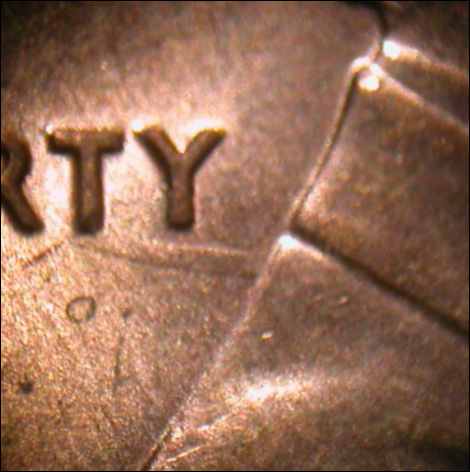
Figure 10. A second 1999 cent with a misaligned and tilted die clash to the left of Lincoln’s coat in almost the same position. Coin courtesy of Richard Imburgia.
 Our last specimen – a 2000 cent – comes from Bob Mohan. We see the incuse, mirror-image letters “URIBUS” in the gap between the base of Lincoln’s bust and the design rim (Figure 11). This is the only specimen so far where a shift to the north is indicated. Evidently the hammer die was misaligned about 14% toward the north, and the perimeter of the obverse die face contacted the motto above the Memorial (PLURIBUS).
Our last specimen – a 2000 cent – comes from Bob Mohan. We see the incuse, mirror-image letters “URIBUS” in the gap between the base of Lincoln’s bust and the design rim (Figure 11). This is the only specimen so far where a shift to the north is indicated. Evidently the hammer die was misaligned about 14% toward the north, and the perimeter of the obverse die face contacted the motto above the Memorial (PLURIBUS).
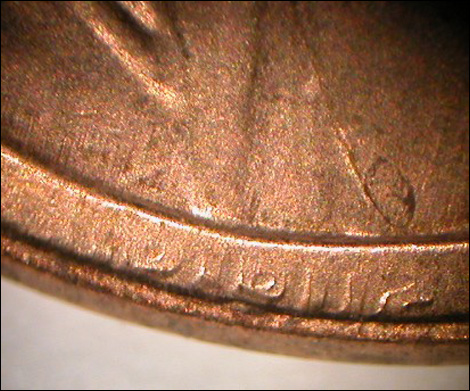
Figure 11. A 2000 cent with a misaligned and tilted die clash located in the gap between Lincoln’s bust and the design rim. This is the only example so far with the misalignment toward the north. Coin courtesy of Bob Mohan.
 These nine cents are not the only examples of extreme misaligned/tilted die clashes from the years 1992 – 2000. Richard Imburgia has come up with several other candidates. However, some of these were questionable as they consisted of only a very faint, very short ridge that could just as easily have been a die gouge or die dent. One or two others were good candidates, but so faint that they were impossible to photograph adequately. These other specimens – both legitimate and questionable – show the predominant pattern of a southward misalignment and downward tilt toward the south.
These nine cents are not the only examples of extreme misaligned/tilted die clashes from the years 1992 – 2000. Richard Imburgia has come up with several other candidates. However, some of these were questionable as they consisted of only a very faint, very short ridge that could just as easily have been a die gouge or die dent. One or two others were good candidates, but so faint that they were impossible to photograph adequately. These other specimens – both legitimate and questionable – show the predominant pattern of a southward misalignment and downward tilt toward the south.
 After all this, what can we conclude? First of all, I think something strange is going on that sets these specimens apart from conventional die clashes. The extreme misalignments and consistent tilting are not consistent with run-of-the-mill press malfunctions. Misaligned die errors of over 10% are very rare, yet most of these coins indicate misalignments of 20% or more. Tilted die errors (vertical misalignments) are quite rare, yet the vast majority of these clashes show unmistakable evidence of severe die tilt. I previously speculated that perhaps bored technicians were clacking dies together. But the consistent directionality of the horizontal and vertical misalignments would seem to undermine that hypothesis. Perhaps these are mishaps that occur during installation.
After all this, what can we conclude? First of all, I think something strange is going on that sets these specimens apart from conventional die clashes. The extreme misalignments and consistent tilting are not consistent with run-of-the-mill press malfunctions. Misaligned die errors of over 10% are very rare, yet most of these coins indicate misalignments of 20% or more. Tilted die errors (vertical misalignments) are quite rare, yet the vast majority of these clashes show unmistakable evidence of severe die tilt. I previously speculated that perhaps bored technicians were clacking dies together. But the consistent directionality of the horizontal and vertical misalignments would seem to undermine that hypothesis. Perhaps these are mishaps that occur during installation.
 There are lots of other odd patterns to ponder. Why only cents? Why only this decade? Why nothing after 2000?
There are lots of other odd patterns to ponder. Why only cents? Why only this decade? Why nothing after 2000?
 As we ponder these questions, we can take satisfaction in the certainty that more of these intriguing errors await discovery.
As we ponder these questions, we can take satisfaction in the certainty that more of these intriguing errors await discovery.
References
Diamond, Mike (2004a) Some recent misaligned die clashes. Errorscope, May/June, pp. 5 - 9
Diamond, Mike (2004b) Another modern misaligned die clash. Errorscope, July/August, p. 29
Diamond, Mike (2004c) Horizontal misalignments of the anvil die. Errorscope, Sept/Oct, pp. 9 – 17

